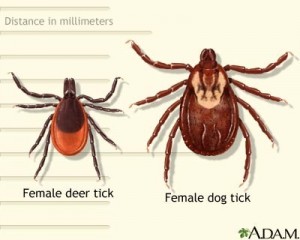When Removing Invasive Plants, Safety First
Published on August 26, 2015
Summer time is a great time to get out and pull invasive plants, but it is also the season that you will most likely encounter safety hazards when working outdoors. Make sure to protect yourself before you head out into the woods.
General Considerations
Below is a list of general safety precautions that you can take before you remove invasive plants in Arlington’s parks.
- Register with Arlington’s Volunteer Office.
- Wear long sleeves, pants, and sturdy shoes.
- Tell someone you are going.
- Carry a cell phone and emergency numbers.
- Bring water, hat, and rain gear.
- Bring a first aid kit and EpiPen if you are allergic to bees.
- Use Ivy-X or Technu pre- and post-contact gel.
- Wear sunscreen and bug/tick repellent.
- Wash up and check for ticks, wash clothes after working.

Poison Ivy
Poison ivy is the most common hazard you will come across working in Arlington Parks – and it is present year round. Of course, poison ivy is more of a threat during the summer when its leaves are out. You can identify poison ivy by remembering “leaves of three, let it be.” Poison ivy is a deciduous woody plant that can grow on the ground or can climb trees like a vine. The vine has reddish hairs that also contain urushiol oil which can spread on your skin or clothes and cause an allergic reaction.

Ticks
Several ticks are present in Arlington, but the only carrier of Lyme disease is the blacklegged tick (Ixodes scapularis), formerly known as the “deer tick.” Ticks are more common in the spring and fall, but can be present throughout the year. The best way to protect your self is by wearing long sleeves and pants and tucking your pant legs into your socks. You can also apply tick repellent. Finally, you can wear light colored clothing so the ticks are easier to see and perform a “tick check” when you get home.
Yellow Jackets
One of the worst hazards of working outside is the threat of encountering yellow jackets. Yellow jackets build their nests on the ground in forests and meadows and you don’t usually see them until you have disturbed their nest! Yellow jackets can sting multiple times and if their nest is disturbed, usually several will come after you. The best way to protect yourself is to be aware of your surroundings. You can usually see the yellow jackets flying in and out of their nest. If you see yellow jackets in the area, make sure you play it safe!

Photo courtesy f E.R. Degginger